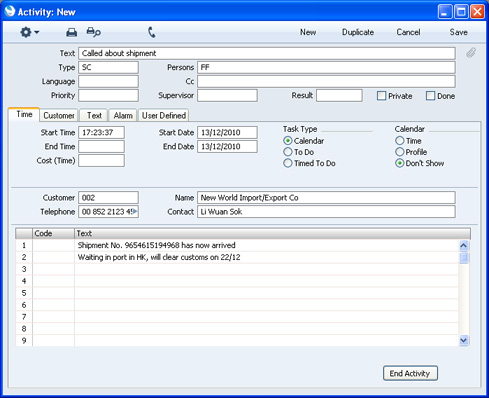Entering an Activity
You can enter Activities in many ways:
- From any view, click the [New Activity] button in the top right-hand corner or use the Ctrl-N (Windows) or ⌘-N (Mac OS X) keyboard shortcut. The Task Type of the new Activity will be Calendar, and the Symbol will be Other. The Start Date and Start Time of the new record will show the current date and time.
- When viewing an existing Activity, click the [Duplicate] button in the Button Bar or use the Ctrl-K (Windows) or ⌘-Y (Mac OS X) keyboard shortcut. The Start Date of the copied Activity will be copied to the new one, but the End Date will be made blank.
- Having printed the Personal Calendar report to screen, click the "New Activity" text at the top of the report. The Task Type of the new Activity will be Calendar, and the Symbol will be Other. The Start Date and Start Time of the new record will show the current date and time.
- Having printed the Customer Status report to screen, click the "New Activity" text at the top of the report. The Task Type of the new Activity will be To Do, and the Symbol will be Other. The Start Date and Start Time of the new record will show the current date and time. If the "New Activity" text is missing from the Customer Status report, the probable cause is that you do not have your own record in the Info on Customer Status Report setting in the Contact module.
- From the Task Manager, click the [New Task] button in the top right-hand corner. The Task Type of the new Activity will be To Do, and the Symbol will be Other. The Start Date and Start Time of the new record will show the current date and time.
- When working with Customer Letters or Quotations, select 'Create Activity' from the Operations menu of the record window to create an Activity relevant to the record you are working with. The Task Type of the new Activity will be To Do, and the Symbol will be Other. The Start Date and Start Time of the new record will vary, depending on the register from which it was created. The Activity Type will be taken from the Activity Types, Subsystems setting. When you select the 'Create Activity' function, the new Activity will be opened in a window entitled 'Activity: Inspect'. This means that it has been saved and is been opened for checking. After amendment if necessary, save the record by clicking the [Save] button in the Button Bar. Alternatively, if you no longer require the Activity, select 'Delete' from the Record menu.
You can also create Activities from Contacts and Mails using the 'Create Activity' Operations menu function. In these cases, the new Activity will not be given a default Activity Type.
The Activity and the originating record will remain connected to each other through the Attachments facility. This allows you to open the originating record quickly and easily when reviewing the Activity, or to open the Activity from the originating record. When viewing the Activity or originating record, click the button with the paper clip image to open a list of attachments. Then double-click an item in this list to open it.
- When working with Customer Letters and Mails, you can have Activities created automatically when you approve records and save them. This is controlled by the Activity Types, Subsystems setting. Such Activities are created and saved, but are not automatically opened for checking or modification. Again, the Activity and the originating record will remain connected to each other through the Attachments facility.
- You can have a new Activity created automatically from an old one when you enter a Result and save it. This depends on the Activity Type/Result combination and is controlled by the Activity Consequences setting. Such Activities are created and saved, but are not automatically opened for checking or modification. The old and new Activities will remain connected to each other through the Attachments facility.
- If you call a Contact from the 'Business Communicator' window, when the call is answered a new Activity window will be opened, allowing you to record the details of the conversation immediately. When the call ends, click the [End Activity] button in the Activity: this will bring an End Time and Cost (Time) in to the Activity and will also save the Activity.
Similarly, if one of your Contacts calls you using Skype or SIP and your Standard CRM database is open, a new Activity window will be opened, again allowing you to record the details of the conversation. The Task Type of these Activities will be To Do, the Calendar Type will be Don't Show and the Symbol will be Call.
Whichever method you use, when the Activity window opens, enter the details of the event as necessary. In the case of future appointments, you will easily be able to return to the record to review it and mark it as completed at the appropriate time.

Since the amount of information stored about each Activity will not fit on a single screen, the Activity window has been divided into five cards. At the top of each is the header. This contains the Text and Type and an indication of whether the Activity has been approved (completed). There are five named buttons ('tabs') in the header.

By clicking the tabs you can navigate between the cards, and always go directly to a certain card. The header is always visible, so you can always identify the Activity you are working with.
---
In this chapter:
Go back to:
